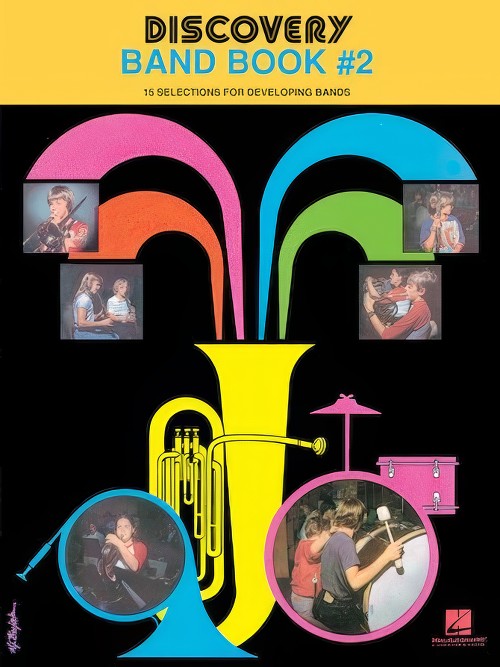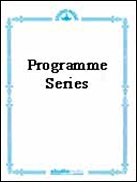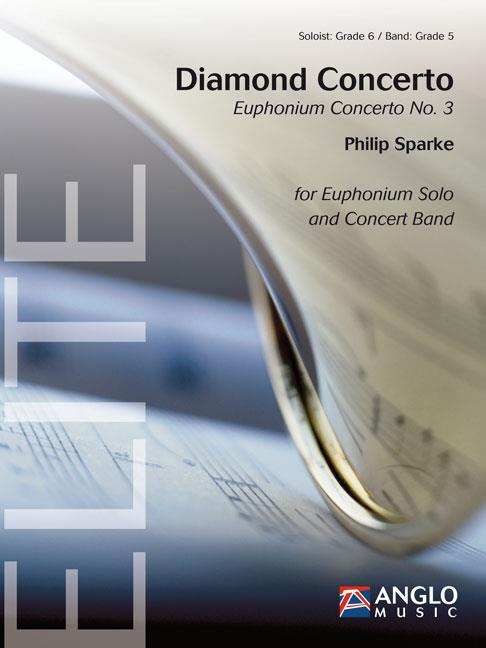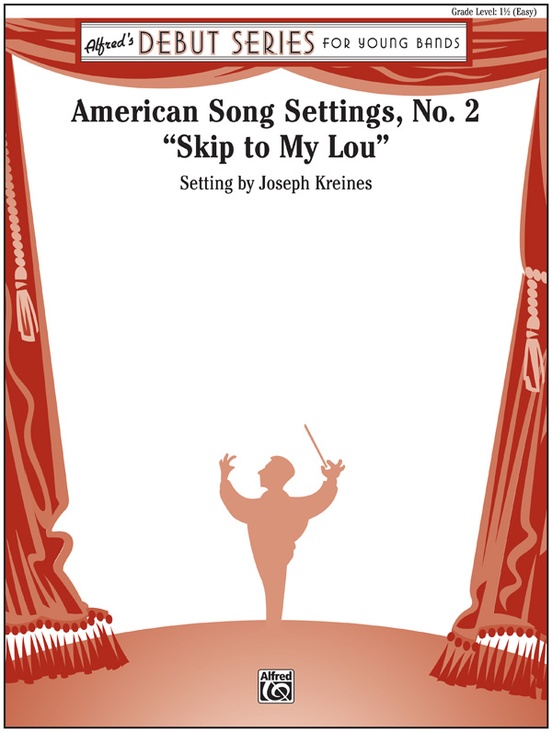Results
-
 £2.85
£2.85Discovery Band Book No.2 (Oboe) - Edmondson & McGinty
Contents:Concert Warm-Ups and Chorales No.2Acapulco HolidayAnchors AweighAtlantisThe Coventry CarolThe Duke of BedfordDr. DixielandIf I Were a Rich ManMickey Mouse MarchPep Rally RockSax-O-MaticSomewhere Out ThereThe Sound of MusicThree Carols for ChristmasTreasury of Carols
Estimated dispatch 7-14 working days
-
 £2.85
£2.85Discovery Band Book No.2 (Flute) - Edmondson & McGinty
Contents:Concert Warm-Ups and Chorales No.2Acapulco HolidayAnchors AweighAtlantisThe Coventry CarolThe Duke of BedfordDr. DixielandIf I Were a Rich ManMickey Mouse MarchPep Rally RockSax-O-MaticSomewhere Out ThereThe Sound of MusicThree Carols for ChristmasTreasury of Carols
Estimated dispatch 7-14 working days
-
 £15.99
£15.99Discovery Band Book No.2 (Conductor) - Edmondson & McGinty
Contents:Concert Warm-Ups and Chorales No.2Acapulco HolidayAnchors AweighAtlantisThe Coventry CarolThe Duke of BedfordDr. DixielandIf I Were a Rich ManMickey Mouse MarchPep Rally RockSax-O-MaticSomewhere Out ThereThe Sound of MusicThree Carols for ChristmasTreasury of Carols
Estimated dispatch 7-14 working days
-
 £12.95
£12.95SALAMANCA (Peninsula March No.1) (Programme Concert Band Extra Score) - Ellerby, Martin
Extra Score. The Peninsula marches were written for the Coldstream Guards Band in celebration of two great battles the regiment was involved in and fought in Spain in the early 19th Century. The battle of Salamanca, fought in 1812, was one of the duke of Wellington's most dramatic victories and this minor key march caputres the turmoil of such a momentous event. Also available Vitoria (Peninsular March No.1) Duration: 3:05 Grade 3
Estimated dispatch 7-14 working days
-
 £39.60
£39.60Symphony No.1 Theme (Concert Band - Score and Parts)
The Johannes Brahms Symphony No. 1 Theme is designed to give your best players an opportunity to play a solo with band accompaniment. This solo is the same one that appears on page 36, book 1 of The Yamaha Advantage for oboe, bassoon, alto clarinet, tenor saxophone and horn. This arrangement also includes solo parts for Flute, Clarinet and Alto Saxophone. This piece can also be performed by band alone.
Estimated dispatch 7-14 working days
-
 £58.50
£58.50Vocalise, Opus 34, No. 14 - Sergei Rachmaninoff / arr. Donald Hunsberger
Among all of Rachmaninoff's works known to today's concert audiences, no work bears the high reputation of his haunting , a work without text for soprano and keyboard. It has been cast into numerous orchestrations, and this particular setting is without parallel in modern day wind band timbres. This score is dedicated to Frederick Fennell in celebration of his 90th birthday, July 2, 2004.
Estimated dispatch 3-5 working days
-
 £309.99
£309.99Symphony No. 9, Op. 160 - James Barnes
Premiered on September 21, 2018 in Lawrence, Kansas by the University of Kansas Wind Ensemble (Dr. Paul Popiel, conducting), James Barnes' Ninth Symphony was composed between January and late June of that same year. This large work was commissioned by a consortium of twenty-one college bands, community bands, professional bands and individuals to help mark the 70th birthday of the composer (b. 1949). It is an expansive forty-minute work in four movements, of which the composer writes, This is my last symphony... this work represents a compendium of all that I have learned during the fifty years of composing and scoring for this wonderful new medium: the modern wind band. The first movement, subtitled Elegy, is based around G minor. It is the longest movement of the symphony. Tragic and despondent in character, it is cast in sonata-allegro form. The second movement is entitled Scherzo. Barnes claims that I have always wanted to write a waltz, and that is how this movement is cast, in a modified rondo form in D minor. In contrast to the mood of the first movement, the scherzo is a delightful posy of expansive melody, splashy color, humor and rhythm. The third movement, which is in a modified tertiary form, is entitled Night Music. In contrast to the scherzo, this movement begins with a mysterious incantation, first displayed by solo Alto flute. The music becomes even darker and more mysterious, while overall the movement effectively expresses an otherworldly mood, ending with a solo soprano offstage which suddenly emerges, eerily singing a modified version of the opening incantation. Cast in sonata-allegro form, the fourth movement is most definitely a rousing Finale, beginning with a brilliant fanfare and undergoing several mood transformations before emerging into the final coda, ending the symphony with an energetic splash of color.
Estimated dispatch 7-14 working days
-
 £274.99
£274.99Symphony No. 2: States Of Mind, Opus 87 - Teo Aparicio-Barberán
I- Logos (reason)II- Pathos (emotion)III- Ethos (credibility)The ancient Greeks believed that music shaped the character of man. In Egyptian temples, music was an essential part of the magical rites to alter the course of nature or to treat illness.And today we know that sound can actually alter matter. The secret of music lies in harmony and mathematics, as many great musicians and experts have always known.One of the most important qualities of music is that it enables the listener to focushis attention inwards instead of on what is around him. It is indisputable that music can inspire emotion. Music leads us into a universe of emotions that are difficult to put into words. In short, music reaches into corners of our soul and thoughtsthat words cannot reach and makes it possible to more clearly describe these different States of mind.The composer of this symphony also believes that each "musical argument" must be constructed so that it will induce the desired reaction in thelistener.Music: more than wordsIn recent times, most orchestral symphonies have been based on a story, a text or something similar so that their composition must be structured accordingly.The intention of this work by Teo Aparicio-Barbern is quitedifferent. The composer describes the three elements of the argument as the only formal structure of the work. Since certain philosophers in world history were able to subdivide grammatical argument, why shouldnt that also be possible for the musicalargument?Since ancient times the power of the spoken word has captivated mankind. How can an argument move people and mobilise the masses? Where does the power of words come from today? The answer lays not so much in what people say but in how theysay it.Rhetoric is one of the oldest humanist disciplines in Western civilisation. Aristotle, in the 4th century BC, called it the art of persuasion. Indeed, the terms rhetoric and persuasion are mutually interchangeable.More than 2000 years agoAristotle structured his rhetoric according to the following three elements: the logos, the pathos and the ethos.Logos (words, reason) is the reasoning that gives freedom to the structure of the text by expressing what one wishes to say usingspecialist terms. With logos we create arguments to receive public approval and to defend our ideas.Pathos, the second element, refers to the effective use of public psychology. Pathos can be considered as the capacity to induce the desired emotionalresponse in the public, by creating an emotional connection with the public so that they accept our message.The third element, ethos (credibility), refers to the character of the speaker and is perhaps the most important of the three elements.Aristotle based his concept of ethos upon his belief that truth and justice will always have the upper hand over anger. He believed that what was true and good was easier to prove and was more persuasive.This second orchestral symphony from thecomposer from Enguera follows these three parameters of the argument according to Aristotle. Each movement tries to summon a different state of mind in the listener so that the message itself can be better understood and appreciated. Apart from thesethree general concepts the music is only structured, as Claude Debussy would say, in a "formative way".The first movement, logos, is based on a scherzo melody that undergoes various changes in rhythm and harmony. The arguments are presented by meansof conventional techniques of composition. The second movement, pathos, is characterised by suggestions of sound. It is subdivided into two large parts. The first part is based on a five seven sequence with five sounds that are repeated in differentenvironments, structures and dynamics. The second part, which is largely tonal, brings out more directly the emotional overtones that each argument must have. The third movement, ethos, is a faithful rendition of the composers personality. In thislast part, clear rhythmic sequences stand out, there are large dynamic contrasts and lots of tone variation. In addition, and this is quite in keeping with the composers earlier work, the harmony in States of Mind is handled in a manner that is bothoriginal and efficient, as a result of which Aparicio-Barberns message is well understood by the listener.This second symphony by Teo Aparicio-Barbern is devoted to "my dear Henrie Adams, a guiding light in this eternally dark musical world. Thankyou for everything."
Estimated dispatch 7-14 working days
-
 £209.99
£209.99Diamond Concerto (Euphonium Concerto No.3) (Euphonium Solo with Concert Band - Score and Parts) - Sparke, Philip
Diamond Concerto was commissioned by Musikverein Morschied from Germany - Dr. Eric Grandjean, conductor - for a special concert featuring Steven Mead as guest soloist. Together they gave the world premiere on 28th April 2012 in the town theatre of Idar-Oberstein. The commission is a highlight in the 30-year friendship between composer and soloist, which has included many mutual CD projects and concerts and, now, a concerto. Sparke had Steven Mead's special euphonium sound in his head throughout the composition process and made free use of the variety of styles which the world-renowned virtuoso has made his own during his highly successful solo career.The village of Morschied lies to the west of Frankfurt am Main in the area known as the German Road of Precious Stones, which is famous for its thriving gem industry. Because of this it was decided to give the commission a local connection by choosing the title, Diamond Concerto. Each of the three movements is named after a famous diamond:Earth Star is rather stern in mood, opening with a free fantasy for the soloist over a static chord from the band. This leads to an Allegro Moderato in minor mode where small motives are gradually repeated and developed by both band and soloist.Ocean Dream uses a varied quote from the composer's Music for Battle Creek, including a melting slow melody that was originally written with Steven Mead in mind.Blue Heart was written, at Steven Mead's suggestion, in bebop style and takes the form of a jazz waltz. The quasi-improvisatory central section features a call-and-response passage for the soloist and upper woodwinds.Duration: 15:45
Estimated dispatch 7-14 working days
-
 £41.50
£41.50American Song Settings, No. 2
, the second in a series of wind band settings of familiar melodies, was written for and is dedicated to the Maitland (FL) Middle School Wind Ensemble, Eric Mendez, director. It opens with a short introduction utilizing the opening notes of the melody, proceeding to its first full statement in the upper woodwinds. The second presentation features the trumpets and xylophone followed by a statement in the bass instruments while the melody "Long, Long Ago" appears in the upper voices. A contrasting legato section follows, succeeded by a more rhythmic statement in woodwinds and trumpets. The melody then appears in the alto saxophones with a contrasting idea in upper woodwinds. A marcato statement of the melody appears as a three-bar phrase with a staccato accompaniment. The final section utilizes the style of the opening measures and is expanded to bring the work to a final climactic conclusion.
Estimated dispatch 3-5 working days
